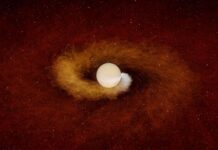 An asteroid traveling at over 28,000 miles per hour passed by the earth on May the 15th, 2018. Not an unusual occurrence at all, but what was alarming was that the asteroid (2010 WC9) had once been known and observed, but then had gone missing; astronomers had not seen it in nearly eight years.
An asteroid traveling at over 28,000 miles per hour passed by the earth on May the 15th, 2018. Not an unusual occurrence at all, but what was alarming was that the asteroid (2010 WC9) had once been known and observed, but then had gone missing; astronomers had not seen it in nearly eight years.
This is the new reality of tracking near-earth objects (NEOs); as we constantly get better at spotting NEOs we are becoming increasingly aware of just how many there are whizzing around the the solar system in general, and of particular concern, how many asteroids there are that venture closer-in to the sun, nearer to the inner rocky planets – our neighborhood. Occasionally, as in the case of 2010 WC9, we can lose track of the orbital path of an asteroid.
The story of the lost-and-found asteroid begins on November 30, 2010. That’s when the asteroid was first spotted by the Catalina Sky Survey in Arizona. The asteroid, which is estimated to be between 200 and 400 feet in diameter, and traveling at 28,655 MPH was receding quickly from our ability to track its motion, and thereby plot its orbit, and by December 10th of that year astronomers lost sight of it completely.
So now we jump forward to May 8th of this year, when astronomers spotted an asteroid and gave it the temporary designation ZJ99C60. But soon thereafter it was realized that the “new” object was actually the asteroid known as 2010 WC9, which had first been seen in November 2010. At that time, astronomers did not get a long enough observation period to accurately plot the course of 2010 WC9, and that is how an asteroid, even one known to be lurking-about among the inner solar system, can get “lost”.
Another interesting (scary) fact about this 300 foot wide rock, traveling at 28,655 MPH, is that it came really close to earth on its latest pass; missing the Earth by about half of the distance to the moon, about 126,000 miles. This is thought to be the closest approach of an asteroid of this size ever recorded.
So now, with its orbit accurately plotted, the lost-and-found asteroid 2010 WC9 is cataloged, along with the 15,000+ NEOs that NASA has spotted – so-far; NASA reports that approximately 30 new NEOs are added to this catalog every week.
To learn more, visit the Planetary Defense Frequently Asked Questions page at NASA.GOV.
If you would like to see something really cool, have a look at this planet motion graphic at RankinStudio.com (http://rankinstudio.com/asteroids/asteroidsv3.1brel.php)
…hint: use the “Change Time Speed” control on the left to speed up the motion of the planets (and 2010 WC9), also put your mouse pointer near the sun, then use your mouse wheel to zoom out to see the relative distance and motion of the outer planets.











